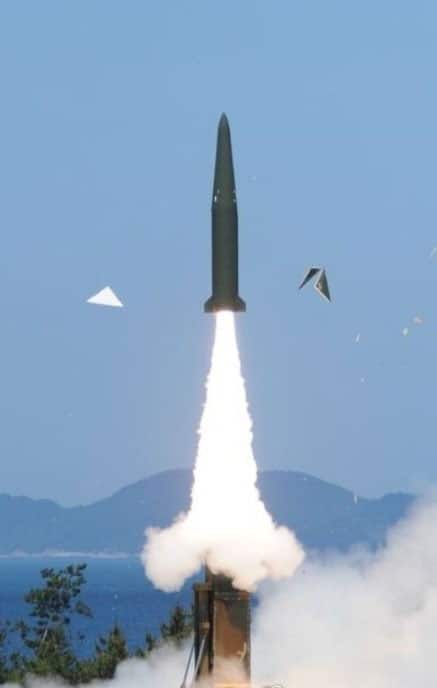The Hyunmoo-2B is a short-range, solid-fueled ballistic missile developed and deployed by South Korea. The missile has a standard range of 500 km, but can travel up to 800 km with a reduced payload. It entered service in 2009 and remains operational.
Hyunmoo-2B at a Glance
- Originated From
- South Korea
- Possessed By
- South Korea
- Alternative Names
- NHK-2 PIP B, NHK-2B, NHK-2 Block B
- Class
- Short-Range Ballistic Missile (SRBM)
- Basing
- Road-mobile
- Length
- >12 m
- Diameter
- 0.9 m
- Launch weight
- 5,400 kg
- Payload
- Unitary warhead, 997 kg
- Warhead
- High explosive (HE), submunitions
- Propulsion
- Two-stage solid propellant
- Range
- 300 km (pre-2012 US-ROK arms control agreement); 500 km (with 997 kg payload) or 800 km (with 500 kg payload)
- Status
- Operational
- In Service
- 2009-Present

Hyunmoo-2B Development
South Korea began developing the Hyunmoo-2B with the goal to improve its ballistic missile strike accuracy.1
It is unclear if the new variant achieved this goal, however, as reports indicate both the Hyunmoo-2A and 2B have an accuracy of 30 m circular error probable (CEP). It was developed by the state-run Agency for Defense Development (ADD) and entered service in 2009.2
Upon entering service, the Hyunmoo-2B had a reported range of 300 km, which was the range limit for ROK ballistic missiles at the time. However, following the US-ROK agreement to extend ROK ballistic missile range limits from 300 to 800 km in September 2012, as well as some technical modifications to the missile, the Hyunmoo-2B became capable of striking targets up to 800 km away.
Specifications
The Hyunmoo-2B has a length of over 12 m, diameter of 0.9 m, and launch weight of approximately 5,400 kg.3
The missile is solid-fueled and two-staged.4 It has a range of 500 km while carrying a 997 kg warhead.5
Reports also indicate that the Hyunmoo-2B can travel up to 800 km with a smaller (500 kg) warhead. The missile has a reported CEP of 30 m.6
Submarine-launched Variant
South Korea’s Agency for Defense Development (ADD) is currently developing a submarine-launched ballistic missile (SLBM), which reports indicate is likely a variant of the Hyunmoo-2A and/or 2B missiles. It is to be fitted aboard the Jangbogo-III (KSS-III), South Korea’s largest (3,000-ton) attack submarine class currently under construction. The unnamed sub-launch variant can reportedly be fired from submarines equipped with the Korean Vertical Launch System (K- VLS). The Jangbogo-III has capacity for up to 10 Hyunmoo-3C cruise missiles and an unknown number of SLBMs.7
Addressing the unusual nature of a conventionally armed SLBM, retired ROK Navy Rear Admiral Kim Hyeok-soo noted that while “the SLBM may lack the accuracy of the SLCM, which is equipped with a [sophisticated] guidance system, its velocity and destructive capability are significantly greater. The deployment of the speedy and stealthy SLBM will allow the South Korean Navy to deliver a blow to North Korea before the situation even escalates to emergency levels.”8
Service History
South Korea first deployed the Hyunmoo-2B in late 2009. The missile’s deployment was reportedly concentrated in the country’s central and eastern portions of its border with North Korea.9
Since its deployment, South Korea has test fired several Hyunmoo-2B missiles. The ROK military test fired a Hyunmoo-2B on April 4, 2014, following a North Korean No Dong test on March 25.10
Two Hyunmoo-2B missiles were test fired in June 2015.11 On June 23, 2017, ROK test fired another two Hyunmoo-2B missiles at Taean-gun, along South Korea’s west coast.12
Footnotes
- “South Korea: Missile,” Nuclear Threat Initiative, April 2016, http://www.nti.org/learn/countries/south-korea/delivery-systems/.
- Kim Minseok & Bradley Perrett, “Seoul’s Latest Ballistic Missile Close To Deployment,” Aviation Week, July 19, 2017, http://m.aviationweek.com/defense/seoul-s-latest-ballistic-missile-close-deployment.
- “Design Characteristics of South Korea’s Ballistic and Cruise Missiles,” Nuclear Threat Initiative, November 2014, http://www.nti.org/media/pdfs/design_characteristics_of_south_korea_missiles.pdf?_=1415661529; Ibid.
- Ibid.
- Franz-Stefan Gady, “South Korea Test Fires New Ballistic Missile,” The Diplomat, April 7, 2017, http://thediplomat.com/2017/04/south-korea-test-fires-new-ballistic-missile/.
- Aviation Week.
- Franz-Stefan Gady, “South Korea to Develop Submarine-Launched Ballistic Missile,” The Diplomat, June 2, 2016, http://thediplomat.com/2016/06/south-korea-to-develop-submarine-launched-ballistic-missile/.
- Ibid.
- “South Korea: Missile,” Nuclear Threat Initiative, April 2016, http://www.nti.org/learn/countries/south-korea/delivery-systems/.
- “South Korea extending ballistic missile range to counter North’s threat,” Reuters, April 3, 2014, http://www.reuters.com/article/us-korea-missile/south-korea-extending-ballistic-missile-range-to-counter-norths-threat-idUSBREA3305H20140404.
- Franz-Stefan Gady, “South Korea to Develop Submarine-Launched Ballistic Missile.”
- Choe Sang-hun, “South Korea Tests Missile Capable of Striking Any Part of the North,” New York Times, June 23, 2017, https://www.nytimes.com/2017/06/23/world/asia/south-korea-missile-ballistic.html.